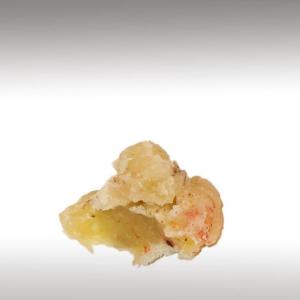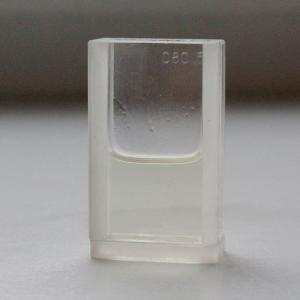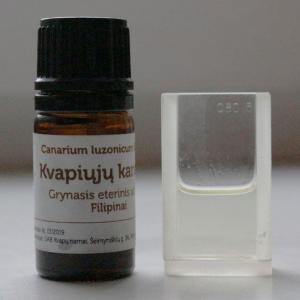
ELEMI ESSENTIAL OIL (CANARIUM LUZONICUM) - ESSENTIAL OILS

BASE / GENERAL DATA
Information submited: May 5, 2014 Modified: March 12, 2018 By: OperaDreamhouse
Canarium Luzonicum commonly known as Elemi, is a tree native to the Philippines, and an oleoresin harvested from it. Elemi resin is a pale yellow substance, of honey-like consistency. Aromatic Elemi oil
is steam distilled from the resin. It is a fragrant resin with a sharp
pine and lemon-like scent. One of the resin components is called amyrin.
Botanical Name: Canarium luzonicum
Common Method of Extraction: Steam Distilled
Part Typically Used: The oleoresin
Color: Pale yellow colour. Pale straw coloured essential oil
Consistency: Slightly oily feeling
Perfumery Note: Base
Strength of Initial Aroma: Pale yellow-white flowers. Woody and balsamic fragrance, with citrus and spicy overtones.
Canarium luzonicum is a tropical dioecious tree or shrub found in the primary forests of Luzon and other islands that make up the Philippines, where it is believed to have originated. It has a spreading habit, alternate pinnate leaves, and small pale yellow-white flowers. This species can easily reach a height of 30 metres. The tree exudes a pale yellow resin when the tree sprouts leaves. The resin solidifies on contact with the air and the resin stops flowing when the tree loses its leaves.
Elemi oleoresin is contained mostly in resin channels on the inside of the bark, and is produced mainly during the rainy season. Like other canarium trees it produces an almond shaped nut which is known locally as ''pili'', and the tree is called ''malapili''. Canarium luzonicum grows mainly in the Philippines, but it is also found in South and Central America, Australia, Brazil, India, the Malay Peninsula, and Moluccas.
Elemi was possibly one of the first aromatics used by the ancient Egyptians to embalm the dead, along with Frankincense, Myrrh, Galbanum and Lebanese Cedar. It is also documented that the Egyptians used it in their daily skincare preparations as well as in medicinal salves, poultices, unguents and incense.
As the oleoresin ages, it becomes waxy and yellow, losing most of its balsamic smell. Elemi essential oil is obtained by distillation of the oleoresin, and is colourless or a very pale yellow. It smells strongly balsamic, hot and aromatic, due to its main constituent, phellandrene.
Elemi resin is a pale yellow substance, of honey-like consistency. Aromatic Elemi oil is steam distilled from the resin. It is a fragrant resin with a sharp pine and lemon-like scent. One of the resin components is called amyrin. (The amyrins are a pair of closely related natural chemical compounds of the triterpene class. They are designated α-amyrin and β-amyrin. Each has the chemical formula C30 H50 O. They are widely distributed in nature and have been isolated from a variety of plant sources.).
Extraction:
The tappers cut into the trunk to remove oblong strips of bark using a wooden mallet and a single edged machete known locally as a 'bolo'. Subsequent strips of bark are removed every few days to stimulate the flow of exudate. The oleoresin is left to trickle down the bark where it becomes waxy, turning a pale yellow colour and resembling crystallized honey in consistency.
After harvesting, the oleoresin is steam distilled to release a colourless or pale straw coloured essential oil with a woody and balsamic fragrance, with citrus and spicy overtones.

SPIRITUAL PRACTISES DATA
Information submited: February 19, 2015 Modified: March 12, 2018 By: OperaDreamhouse
Elemi essential oil open one to mystical experiences and assist in balancing and integrating spiritual and earthly energies.

MEDICINE / HEALTH DATA
Information submited: June 13, 2014 Modified: March 12, 2018 By: OperaDreamhouse
Elemi essential oil was used throughout the Middle East for thousands of years as an antiseptic, and for healing scars and wounds.
At some time during the 16th century Elemi was introduced into Europe and used extensively in folk medicine. It was employed in poultices for ulcerated wounds, ointments and soothing balms for skin infections.
In the 17th century, a pioneering physician named J. J. Wecker used Elemi in salves to treat soldiers who had been injured in battle.
Historically, Elemi was used in soaps and incense, to soothe chest infections, and as a steam inhalation for sinusitis.
The health benefits of Elemi essential oil can be attributed to its properties like antiseptic, analgesic, expectorant, stimulant, tonic, anti-inflammatory, antispasmodic, antimicrobial, anti-depressant, anti-catarrhal, anti-infectious and sedative.
It is used as a herbal medicine to treat bronchitis, catarrh, extreme coughing, mature skin, scars, stress, and wounds. Elemi can be useful with respiratory complaints such as bronchitis, dry cough and excess mucus. It is also helpful in cases of heavy perspiration, cuts and skin infections.
Elemi essential oil is not only applicable in protecting wounds: it is also effective in preventing infections in the urethra, urinary bladder, urinary tract, colon, kidneys, intestines, stomach, and other internal organs.
Elemi oil is helpful in the treatment of the respiratory tract, skin conditions and in lifting the spirit. It can be used in cases of nervous exhaustion and stress related conditions: it gives a feeling of peace.
Elami very good from bronchitis, ulcers, coughs, inflammation (breast and uterus), rashes (allergic) ills.
It is effective in cutting down pain related to colds, fevers, or sprains. It also helps in curing headaches, migraines, muscular pain, pain in the joints, and pain in the ears.
The effect of a stimulant is widespread. It stimulates almost all of the functions in the body. It stimulates circulation, the secretion of hormones and enzymes from the endocrinal glands, the discharge of bile and other gastric juices into the stomach.
Furthermore, it stimulates nervous responses, including those affecting the neurons in the brain, the heartbeat, respiration, peristaltic motion of the intestines, and menstrual discharges, as well as the production and secretion of milk in the breasts. These last two are due to its stimulating effects on certain hormones such as estrogen and progesterone.
Elami essential oil helps in the growth and proper functioning of the body by toning up all the organic systems functioning in the body, such as the respiratory system, the digestive system, the cardio-vascular system, the circulatory system, the neurotic system, the excretory system, the nervous system and the endocrinal system. It also boosts up the immune system of the body.
Side effects:
No special precautions are needed, but please note that Elemi essential oil can be irritating to a sensitive skin.
At some time during the 16th century Elemi was introduced into Europe and used extensively in folk medicine. It was employed in poultices for ulcerated wounds, ointments and soothing balms for skin infections.
In the 17th century, a pioneering physician named J. J. Wecker used Elemi in salves to treat soldiers who had been injured in battle.
Historically, Elemi was used in soaps and incense, to soothe chest infections, and as a steam inhalation for sinusitis.
The health benefits of Elemi essential oil can be attributed to its properties like antiseptic, analgesic, expectorant, stimulant, tonic, anti-inflammatory, antispasmodic, antimicrobial, anti-depressant, anti-catarrhal, anti-infectious and sedative.
It is used as a herbal medicine to treat bronchitis, catarrh, extreme coughing, mature skin, scars, stress, and wounds. Elemi can be useful with respiratory complaints such as bronchitis, dry cough and excess mucus. It is also helpful in cases of heavy perspiration, cuts and skin infections.
Elemi essential oil is not only applicable in protecting wounds: it is also effective in preventing infections in the urethra, urinary bladder, urinary tract, colon, kidneys, intestines, stomach, and other internal organs.
Elemi oil is helpful in the treatment of the respiratory tract, skin conditions and in lifting the spirit. It can be used in cases of nervous exhaustion and stress related conditions: it gives a feeling of peace.
Elami very good from bronchitis, ulcers, coughs, inflammation (breast and uterus), rashes (allergic) ills.
It is effective in cutting down pain related to colds, fevers, or sprains. It also helps in curing headaches, migraines, muscular pain, pain in the joints, and pain in the ears.
The effect of a stimulant is widespread. It stimulates almost all of the functions in the body. It stimulates circulation, the secretion of hormones and enzymes from the endocrinal glands, the discharge of bile and other gastric juices into the stomach.
Furthermore, it stimulates nervous responses, including those affecting the neurons in the brain, the heartbeat, respiration, peristaltic motion of the intestines, and menstrual discharges, as well as the production and secretion of milk in the breasts. These last two are due to its stimulating effects on certain hormones such as estrogen and progesterone.
Elami essential oil helps in the growth and proper functioning of the body by toning up all the organic systems functioning in the body, such as the respiratory system, the digestive system, the cardio-vascular system, the circulatory system, the neurotic system, the excretory system, the nervous system and the endocrinal system. It also boosts up the immune system of the body.
Side effects:
No special precautions are needed, but please note that Elemi essential oil can be irritating to a sensitive skin.

BEAUTY / COSMETICS DATA

FOOD / COOKING DATA
COMMENTS
No comments.





